Biology
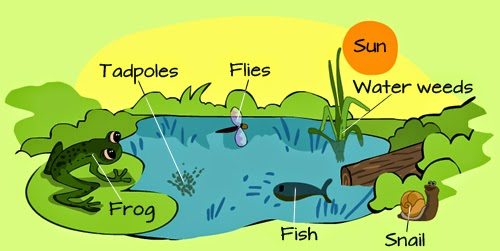 1 A habitat is a place where an organism lives. The niche of an organism is the role that it plays in the community.
1 A habitat is a place where an organism lives. The niche of an organism is the role that it plays in the community.
- Ecology Revision
Ecology The following are some points to help you, it does not contain everything! You must revise on your own making summary notes and diagrams to help you. You have your notes, this web and your text book to help you. Please use all of these resources,...
- Homework The Carbon And Nitrogen Cycles
Please make sure that your questions on the carbon cycle are complete and in detail. Please write half a page about the nitrogen cycle. The notes below will help. Please answer the questions about the nitrogen cycle. I will collect it all on friday. The...
- #65 Ecology
Ecology is the study of the ways in which organisms interact with their environment. Levels of ecological organisation A habitat is a type of environment in which an organism lives. For example, the habitat of a giraffe is grassland (savannah) with...
- #64.1 Ecology Syllabus 2015
? Levels of ecological organisation ? Energy flow through ecosystems ? Recycling of nitrogen Learning Outcomes Candidates should be able to: (a) define the terms habitat, niche, population, community and ecosystem and be able to recognise examples...
- Photosynthesis And Cellular Respiration
Photosynthesis is the processes of converting carbon dioxide and water, using light energy, into glucose and oxygen. Plants, algae, and certain prokaryotes capture about 1% of the energy in the sunlight that reaches Earth and convert it to chemical energy...
Biology
# 67 Summary of Ecology
 1 A habitat is a place where an organism lives. The niche of an organism is the role that it plays in the community.
1 A habitat is a place where an organism lives. The niche of an organism is the role that it plays in the community.2 A population is a group of organisms of the same species, living in the same place at the same time, that can interbreed with one another. A community is all the organisms, of all the diff erent species, living in the same place at the same time.
3 An ecosystem is an interacting system of organisms and their environment, more or less self-contained.
4 Energy flows from one organism to another in the form of chemical energy in organic molecules in food. The pathways of energy flow can be shown in a food chain or food web, in which the arrows show the direction of energy flow.
5 The first organism in a food chain or food web is a producer. In most food chains, plants are the
producers. They transfer energy from sunlight into chemical energy in organic molecules in the process of photosynthesis. All other organisms in a food chain are consumers.
6 Each step in a food chain is a trophic level. Energy is lost as it passes from one trophic level to the next. The percentage of energy in one trophic level that passes to the next trophic level is generally around 10%. Th is value is the effi ciency of energy transfer. It is generally relatively low for transfers from producers to primary consumers, because of the high content of cellulose in plants, which is not easily digested by most animals but contains a lot of energy.
7 Nitrogen atoms are an essential part of many organic molecules, especially proteins and nucleic acids. Although a high percentage of the atmosphere is nitrogen gas, nitrogen molecules are very unreactive and cannot be used by most living organisms. The nitrogen must be fi xed ? converted into a more reactive form such as ammonium ions or nitrate ions ? before plants can make use of it. Lightning and nitrogen-fixing bacteria are the two most important natural methods of nitrogen fixation.
8 Plants use ammonium ions or nitrate ions to make amino acids and then proteins. Consumers obtain amino acids from plants.
9 Decomposers break down nitrogen-containing molecules in dead plants and animals, or in their
waste products, such as urea. Ammonia is produced, which is converted to nitrite ions and then nitrate ions by nitrifying bacteria. Denitrifying bacteria convert nitrate ions back to nitrogen gas.
1 Which ecological term is defined as ?the particular location and type of environment occupied by an organism??
A ecosystem
B habitat
C niche
D population
3 Which step in a marine food chain involves transfer of energy from trophic level 2 to trophic level 3?
A phytoplankton carry out photosynthesis
B zooplankton feed on phytoplankton
C small fish feed on zooplankton
D large fish feed on smaller fish
4 Which step in a marine food chain involves the smallest transfer of energy?
A phytoplankton carry out photosynthesis
B zooplankton feed on phytoplankton
C small fish feed on zooplankton
D large fish feed on smaller fish
5 Which statement explains why herbivores obtain and store in their bodies less than 10% of the net primary productivity of the plants available for them to eat?
A Not all parts of a plant are available to be eaten.
B Not all parts of a plant can be digested.
C Some plant material is tough or distasteful and is not eaten.
D Some plant material is eaten by other herbivores.
6 Which bacterial reaction in the nitrogen cycle decreases soil fertility?
7 Rhizobium bacteria form colonies in nodules on the roots of some plants.
What is the role of these bacteria in the nitrogen cycle?
A to produce ammonium ions from nitrogen gas
B to produce ammonium ions from urea
C to produce nitrate ions from nitrite ions
D to produce nitrogen gas from nitrate ions
8 The percentage of energy consumed by an organism that is actually absorbed by the organism varies for different foods.
The table shows the percentage absorption of different foods by small birds.
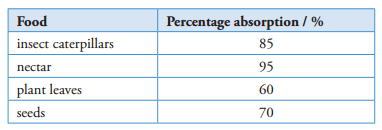
What explains the differences in percentage absorption?
A A bird in trophic level 3 uses more energy to digest its food than any of the birds in trophic level 2.
B More energy is used to digest caterpillars than to digest seeds.
C Nectar requires little energy to digest.
D Seeds contain more cellulose than do plant leaves.
9 The energy trapped by grassland plants is 10 000 kJm?2year?1 .

B 0.40%
C 3.2%
D 4.0%
10 Plots of white clover plants were inoculated with three different strains of Rhizobium bacteria, P, Q and R, and the mass of harvested clover compared with that from plots that were not inoculated and plots that were treated with nitrate fertiliser. The results are shown in the table.
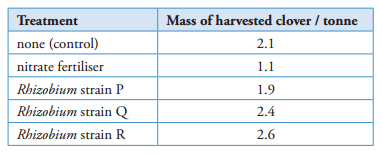
What may be concluded from these results?
1 Adding nitrate fertiliser increases the growth of white clover.
2 Inoculating unfertilised plots of white clover with Rhizobium increases growth of the clover.
3 Different strains of Rhizobium differ in their ability to fix nitrogen.
A 1, 2 and 3
B 1 and 2 only
C 2 and 3 only
D 3 only
Answers to Multiple choice test
3 An ecosystem is an interacting system of organisms and their environment, more or less self-contained.
4 Energy flows from one organism to another in the form of chemical energy in organic molecules in food. The pathways of energy flow can be shown in a food chain or food web, in which the arrows show the direction of energy flow.
5 The first organism in a food chain or food web is a producer. In most food chains, plants are the
producers. They transfer energy from sunlight into chemical energy in organic molecules in the process of photosynthesis. All other organisms in a food chain are consumers.
6 Each step in a food chain is a trophic level. Energy is lost as it passes from one trophic level to the next. The percentage of energy in one trophic level that passes to the next trophic level is generally around 10%. Th is value is the effi ciency of energy transfer. It is generally relatively low for transfers from producers to primary consumers, because of the high content of cellulose in plants, which is not easily digested by most animals but contains a lot of energy.
7 Nitrogen atoms are an essential part of many organic molecules, especially proteins and nucleic acids. Although a high percentage of the atmosphere is nitrogen gas, nitrogen molecules are very unreactive and cannot be used by most living organisms. The nitrogen must be fi xed ? converted into a more reactive form such as ammonium ions or nitrate ions ? before plants can make use of it. Lightning and nitrogen-fixing bacteria are the two most important natural methods of nitrogen fixation.
8 Plants use ammonium ions or nitrate ions to make amino acids and then proteins. Consumers obtain amino acids from plants.
9 Decomposers break down nitrogen-containing molecules in dead plants and animals, or in their
waste products, such as urea. Ammonia is produced, which is converted to nitrite ions and then nitrate ions by nitrifying bacteria. Denitrifying bacteria convert nitrate ions back to nitrogen gas.
1. Multiple-choice test
1 Which ecological term is defined as ?the particular location and type of environment occupied by an organism??
A ecosystem
B habitat
C niche
D population
2 What is meant by an ecosystem?
A all the biotic and abiotic components of a given environment
B all the populations of organisms in a given environment
C all the chemical and physical factors acting in a given environment
D the community of organisms in a given environment
A all the biotic and abiotic components of a given environment
B all the populations of organisms in a given environment
C all the chemical and physical factors acting in a given environment
D the community of organisms in a given environment
3 Which step in a marine food chain involves transfer of energy from trophic level 2 to trophic level 3?
A phytoplankton carry out photosynthesis
B zooplankton feed on phytoplankton
C small fish feed on zooplankton
D large fish feed on smaller fish
4 Which step in a marine food chain involves the smallest transfer of energy?
A phytoplankton carry out photosynthesis
B zooplankton feed on phytoplankton
C small fish feed on zooplankton
D large fish feed on smaller fish
5 Which statement explains why herbivores obtain and store in their bodies less than 10% of the net primary productivity of the plants available for them to eat?
A Not all parts of a plant are available to be eaten.
B Not all parts of a plant can be digested.
C Some plant material is tough or distasteful and is not eaten.
D Some plant material is eaten by other herbivores.
6 Which bacterial reaction in the nitrogen cycle decreases soil fertility?
A oxidation of NH4+ to NO2?by Nitrosomonas
B oxidation of NO2? to NO3?by Nitrobacter
C conversion of N2 to NH4+by bacteria using nitrogenase
D conversion of NO3? to N2by bacteria in water-logged soil
7 Rhizobium bacteria form colonies in nodules on the roots of some plants.
What is the role of these bacteria in the nitrogen cycle?
A to produce ammonium ions from nitrogen gas
B to produce ammonium ions from urea
C to produce nitrate ions from nitrite ions
D to produce nitrogen gas from nitrate ions
8 The percentage of energy consumed by an organism that is actually absorbed by the organism varies for different foods.
The table shows the percentage absorption of different foods by small birds.

What explains the differences in percentage absorption?
A A bird in trophic level 3 uses more energy to digest its food than any of the birds in trophic level 2.
B More energy is used to digest caterpillars than to digest seeds.
C Nectar requires little energy to digest.
D Seeds contain more cellulose than do plant leaves.
9 The energy trapped by grassland plants is 10 000 kJm?2year?1 .
2000 kJm?2 year?1 is used by the plants in respiration.
The energy passed along a food chain based on this grassland is shown, in kJm?2 year?1 .

What percentage of the energy available to the herbivore passes to carnivore 2?
A 0.32%B 0.40%
C 3.2%
D 4.0%
10 Plots of white clover plants were inoculated with three different strains of Rhizobium bacteria, P, Q and R, and the mass of harvested clover compared with that from plots that were not inoculated and plots that were treated with nitrate fertiliser. The results are shown in the table.

What may be concluded from these results?
1 Adding nitrate fertiliser increases the growth of white clover.
2 Inoculating unfertilised plots of white clover with Rhizobium increases growth of the clover.
3 Different strains of Rhizobium differ in their ability to fix nitrogen.
A 1, 2 and 3
B 1 and 2 only
C 2 and 3 only
D 3 only
Answers to Multiple choice test
1. B
2. A
3. C
4. D
5. D
6. D
7. A
8. C
9. B
10. D
10. D
2. End-of-chapter questions
1 Nitrogenase is an enzyme found in nitrogen-fixing bacteria. What reaction is catalysed by nitrogenase?
A the conversion of nitrate ions to nitrite ions
B the conversion of nitrite ions to nitrate ions
C the conversion of nitrogen gas to ammonium ions
D the conversion of nitrogen gas to nitrate ions
2 Which is not a way in which energy is lost between a producer and a primary consumer?
A as chemical energy in the faeces of the primary consumer
B as chemical energy in roots that are not eaten by the primary consumer
C as heat from respiration in the cells of the primary consumer
D as heat from respiration in the cells of the producer
3 Draw a flow diagram to show how an atom of nitrogen in a nitrogen molecule in the air could become part of a protein molecule in a muscle in a person's arm.
Your diagram should:
? name the molecules or ions in which the nitrogen atom is present, at each stage
? name the processes involved in the conversion of one substance to another, or in the passing of a substance from one organism to another
You will need to use knowledge of the nitrogen cycle in your answer. You may also use knowledge of digestion, absorption, transport in mammals and protein synthesis in cells.
4 a Explain what is meant by the term community.
b The figure shows the How of energy through a woodland. All figures are in kJ m?2 per week. [2]
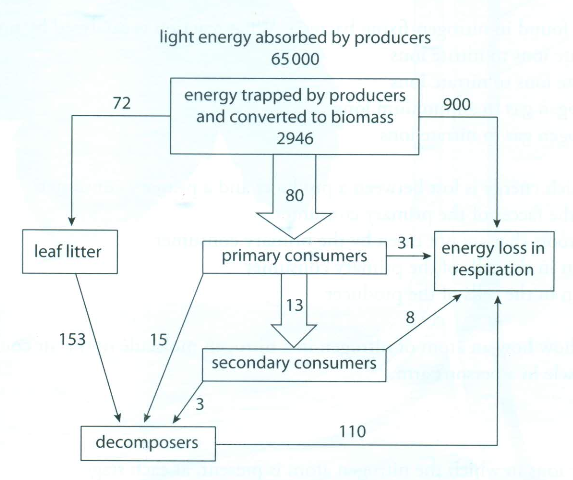
i Calculate the energy trapped by the producers and converted to biomass, as a percentage of the light energy absorbed. Express your answer to the nearest 0.1 %. Show your working. [2]
ii Suggest, in terms of energy How, why there are no tertiary consumers in the woodland. [2]
iii Leaf litter is composed of dead leaves and twigs.
The total energy in the leaf litter was 15 899 kJm?2 but only 153 kJm?2 per week was transferred to decomposers. When animal wastes rich in nitrogen were mixed with the leaf litter the energy flow to decomposers increased significantly.
Suggest why the addition of animal wastes rich in nitrogen increased the energy How to decomposers. [3]
[Cambridge International AS and A Level Biology 9700 Paper 22, Question 6, November 2009]
5 Many species of legume grow in nitrate-deficient Soils in the tropics. Some of these are large trees such as the flamboyant tree, Delonix regia.
Bacteria of the genus Rhizobium live inside swellings along the roots of legumes. These swellings are known as root nodules.
A student followed the cycling of nitrogen in an area with many flamboyant trees.
The figure summarises the flow of nitrogen in the area.
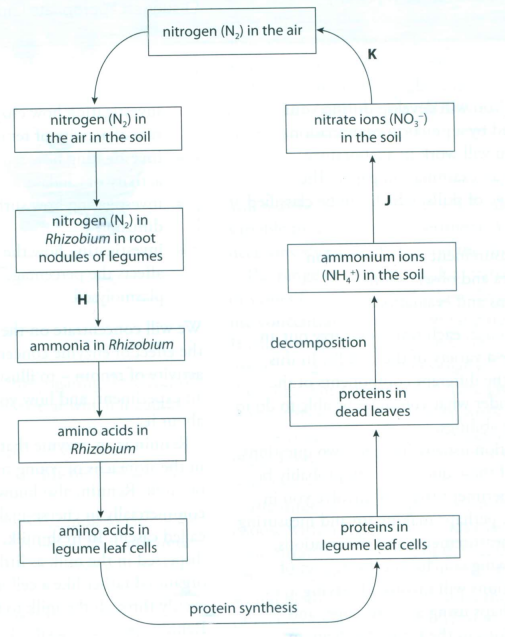
Cambridge International Examinations bears no responsibility for the example answers to questions taken from its past question papers which are contained in this publication.
1 C
2 C
3 The answer could include the following points, shown in the form of a flow diagram:
? nitrogen fixation ? conversion of N2 to a named compound or compound ion by a named process (e.g. to NH4 + by Rhizobium in root nodules)
? production of proteins in the plant on ribosomes
? eating of plant by a person (or by another animal that will eventually provide food for a person)
? digestion of protein in the alimentary canal by protease enzymes, followed by absorption through the walls of the small intestine as amino acids
? transport of amino acids in solution in blood plasma
? uptake of amino acids from blood by muscle cells (reference to diff usion through capillary wall, tissue fluid)
? protein synthesis on ribosomes in muscle cell, involving mRNA and tRNA
Exam-style questions

4 a all the organisms of all species; living in the same place at the same time; [2]
b i 2946 ÷ 65 000 × 100; = 4.5%; [2]
ii not enough energy reaching them; only 2 kJ m?2 per week; [2]
(leaf litter contains) little protein/nitrogen;
lack of nitrogen is a limiting factor for decomposer activity;
animal wastes contain urea/amino acids/ organic nitrogen sources;
provide materials for decomposers/increase rate of decomposer activity; [max. 3]
5 a H = nitrogen fi xation;
J = nitrifi cation/oxidation;
K = denitrifi cation/reduction; [3]
b provide ammonium ions;
for use in making amino acids/proteins;
allow plant to grow in soil that is low in nitrate ions; [max. 2]
1 Nitrogenase is an enzyme found in nitrogen-fixing bacteria. What reaction is catalysed by nitrogenase?
A the conversion of nitrate ions to nitrite ions
B the conversion of nitrite ions to nitrate ions
C the conversion of nitrogen gas to ammonium ions
D the conversion of nitrogen gas to nitrate ions
2 Which is not a way in which energy is lost between a producer and a primary consumer?
A as chemical energy in the faeces of the primary consumer
B as chemical energy in roots that are not eaten by the primary consumer
C as heat from respiration in the cells of the primary consumer
D as heat from respiration in the cells of the producer
3 Draw a flow diagram to show how an atom of nitrogen in a nitrogen molecule in the air could become part of a protein molecule in a muscle in a person's arm.
Your diagram should:
? name the molecules or ions in which the nitrogen atom is present, at each stage
? name the processes involved in the conversion of one substance to another, or in the passing of a substance from one organism to another
You will need to use knowledge of the nitrogen cycle in your answer. You may also use knowledge of digestion, absorption, transport in mammals and protein synthesis in cells.
b The figure shows the How of energy through a woodland. All figures are in kJ m?2 per week. [2]

i Calculate the energy trapped by the producers and converted to biomass, as a percentage of the light energy absorbed. Express your answer to the nearest 0.1 %. Show your working. [2]
ii Suggest, in terms of energy How, why there are no tertiary consumers in the woodland. [2]
iii Leaf litter is composed of dead leaves and twigs.
The total energy in the leaf litter was 15 899 kJm?2 but only 153 kJm?2 per week was transferred to decomposers. When animal wastes rich in nitrogen were mixed with the leaf litter the energy flow to decomposers increased significantly.
Suggest why the addition of animal wastes rich in nitrogen increased the energy How to decomposers. [3]
[Total: 9]
[Cambridge International AS and A Level Biology 9700 Paper 22, Question 6, November 2009]
5 Many species of legume grow in nitrate-deficient Soils in the tropics. Some of these are large trees such as the flamboyant tree, Delonix regia.
Bacteria of the genus Rhizobium live inside swellings along the roots of legumes. These swellings are known as root nodules.
A student followed the cycling of nitrogen in an area with many flamboyant trees.
The figure summarises the flow of nitrogen in the area.

a Name the processes that occur at H, J and K. [3]
b Suggest the advantages gained by legumes of having Rhizobium living in their roots. [2]
[Total: 5]
[Cambridge International AS and A Level Biology 9700 Paper 21, Question 6, June 2010 ]
3. End-of-chapter answers
1 C
2 C
3 The answer could include the following points, shown in the form of a flow diagram:
? nitrogen fixation ? conversion of N2 to a named compound or compound ion by a named process (e.g. to NH4 + by Rhizobium in root nodules)
? production of proteins in the plant on ribosomes
? eating of plant by a person (or by another animal that will eventually provide food for a person)
? digestion of protein in the alimentary canal by protease enzymes, followed by absorption through the walls of the small intestine as amino acids
? transport of amino acids in solution in blood plasma
? uptake of amino acids from blood by muscle cells (reference to diff usion through capillary wall, tissue fluid)
? protein synthesis on ribosomes in muscle cell, involving mRNA and tRNA
Exam-style questions

4 a all the organisms of all species; living in the same place at the same time; [2]
b i 2946 ÷ 65 000 × 100; = 4.5%; [2]
ii not enough energy reaching them; only 2 kJ m?2 per week; [2]
(leaf litter contains) little protein/nitrogen;
lack of nitrogen is a limiting factor for decomposer activity;
animal wastes contain urea/amino acids/ organic nitrogen sources;
provide materials for decomposers/increase rate of decomposer activity; [max. 3]
[Total: 9]
J = nitrifi cation/oxidation;
K = denitrifi cation/reduction; [3]
b provide ammonium ions;
for use in making amino acids/proteins;
allow plant to grow in soil that is low in nitrate ions; [max. 2]
[Total: 5]
- Ecology Revision
Ecology The following are some points to help you, it does not contain everything! You must revise on your own making summary notes and diagrams to help you. You have your notes, this web and your text book to help you. Please use all of these resources,...
- Homework The Carbon And Nitrogen Cycles
Please make sure that your questions on the carbon cycle are complete and in detail. Please write half a page about the nitrogen cycle. The notes below will help. Please answer the questions about the nitrogen cycle. I will collect it all on friday. The...
- #65 Ecology
Ecology is the study of the ways in which organisms interact with their environment. Levels of ecological organisation A habitat is a type of environment in which an organism lives. For example, the habitat of a giraffe is grassland (savannah) with...
- #64.1 Ecology Syllabus 2015
? Levels of ecological organisation ? Energy flow through ecosystems ? Recycling of nitrogen Learning Outcomes Candidates should be able to: (a) define the terms habitat, niche, population, community and ecosystem and be able to recognise examples...
- Photosynthesis And Cellular Respiration
Photosynthesis is the processes of converting carbon dioxide and water, using light energy, into glucose and oxygen. Plants, algae, and certain prokaryotes capture about 1% of the energy in the sunlight that reaches Earth and convert it to chemical energy...
